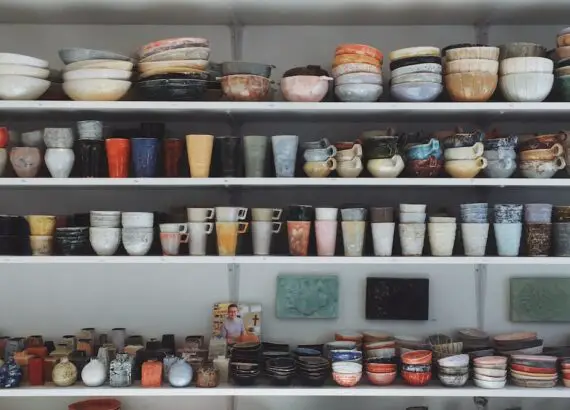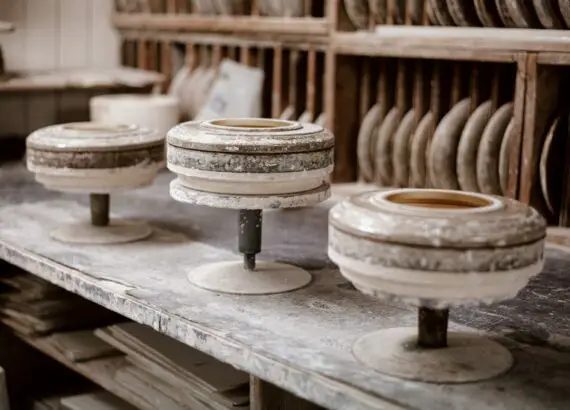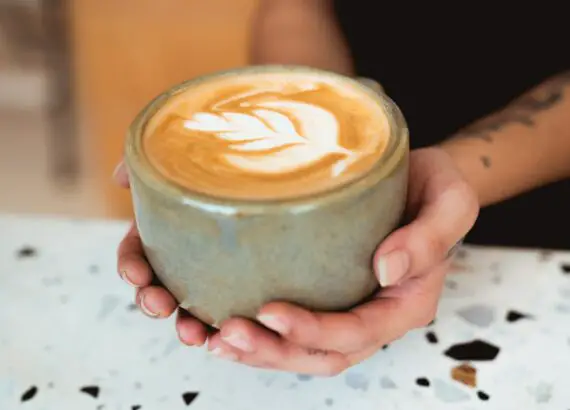Pottery Clay: 17 Important Questions (Quick Answers)
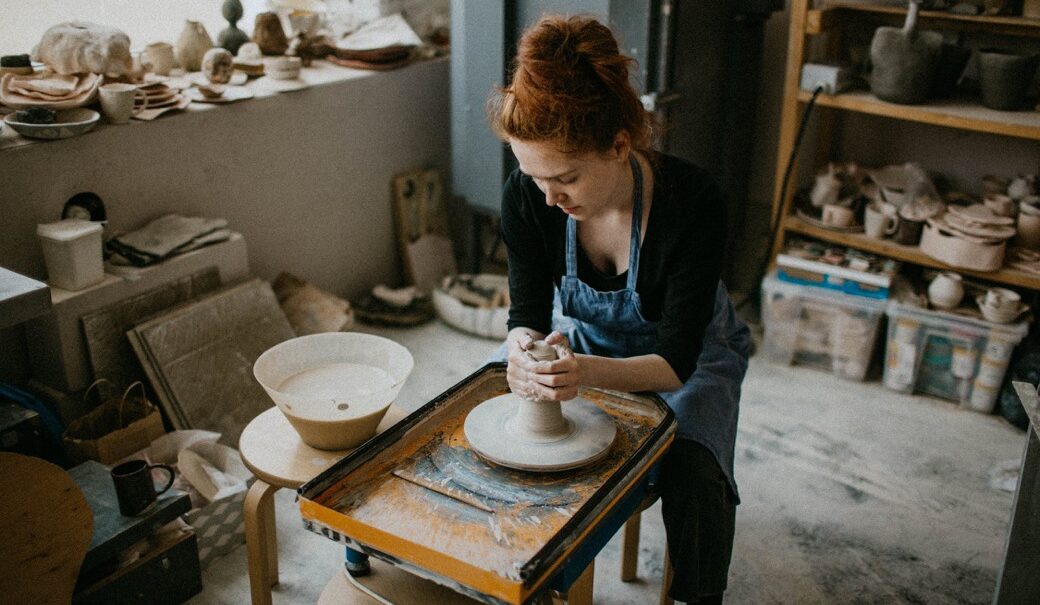
Pottery can become an excellent hobby for those who like to create something with one’s hands. Besides, doing pottery can turn into a great business, as it consumes little time and money.
However, whether you have experience in clay art or you’re a newbie, you’ll need to get the basics of pottery clay, as it’s crucial to know where this material comes from and what minerals and elements it contains.
Check out this article to get the answers to the most common questions about pottery clay background. Figure out what pottery clay is made out of and start creating items that will impress your friends or potential customers.
Table of Contents
1. What Is Pottery Clay and How Is It Formed?
Clay is a natural product formed due to rocks decomposing (i.e., contact of stones with water, air, or steam). This natural material contains all the soil ingredients, including remains of plant life and animals, which are filtered out through rocks and sand within time.
Clay can be divided into two types:
- primary clay;
- and secondary clay.
Primary clay, also known as kaolin clay, contains alumina, silica, and chemical water. Such clay has no impurities, which means it remains white and pure. The secondary clay includes different minerals and organic substances, thus making the material change in color (usually, it is tan, brown, red, or cream).
The distinctive feature of this material is that it becomes plastic when wet, which is why we can make pottery from it. However, it’s also crucial to mention that ceramics can be made not from raw clay but a mix of clay and other minerals.
2. Why Should You Work with Pottery Clay?
If you are a beginner who knows nothing about pottery but wants to create ceramics, pottery clay is what you need.
There are a lot of fascinating facts about pottery clay, and you’ll enjoy the process of exploring the clay art. You can make beautiful items from different clay types in less than an hour. Besides, pottery is always uplifting and relaxing.
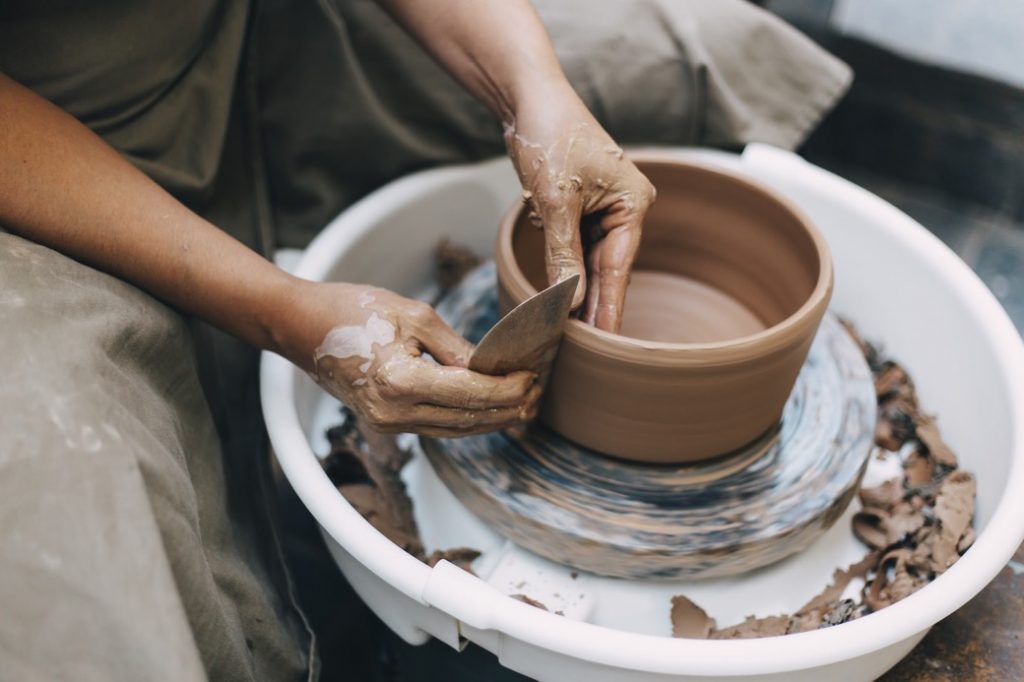
Once you touch the pottery clay, you’ll realize that there is something calming about making pottery using your hands.
Moreover, many people find the process of molding and shaping clay pieces as some kind of meditation. Besides, working with pottery boasts of other valuable effects like:
- the patience level improvement;
- the ability to develop perseverance and become good at coping with challenges;
- the raise of courage and determination from putting yourself as an artist;
- the development of attention to details;
- and, finally, persistence development.
“For a potter to be able to make a pot that has life and vitality there has to be some brain power connected, some intellectual curiosity.”
– Dwight Holland
In addition, pottery clay is a versatility material, so you can use it for creating a diversity of items, including:
- vases to house flowers;
- ceramic tableware (cups, platters, bowls, etc.);
- different jars and teapots;
- pots to put various items in, and more.
Pottery is a fascinating adventure that brings new knowledge and a lot of positive emotions. And despite pottery clay being messy, you will get great satisfaction from the clay art.
Remember, practice is an essential part of your development in pottery art, as it’s impossible to create a fantastic ceramic item without any experience.
3. Where Does Pottery Clay Come From?
Clay is a natural material, which comes from tiny particles of rock eroded by streams, rivers, or rain. It contains all the ingredients of soil like minerals, plant life, and animals, which break up underwater pressure.
Smaller particles settle on the bottom, while larger particles pass through rocks and sand, resulting in silt settling into clay beds.
The distance silt travels from its source and its pureness determines the type of clay it becomes in the future.
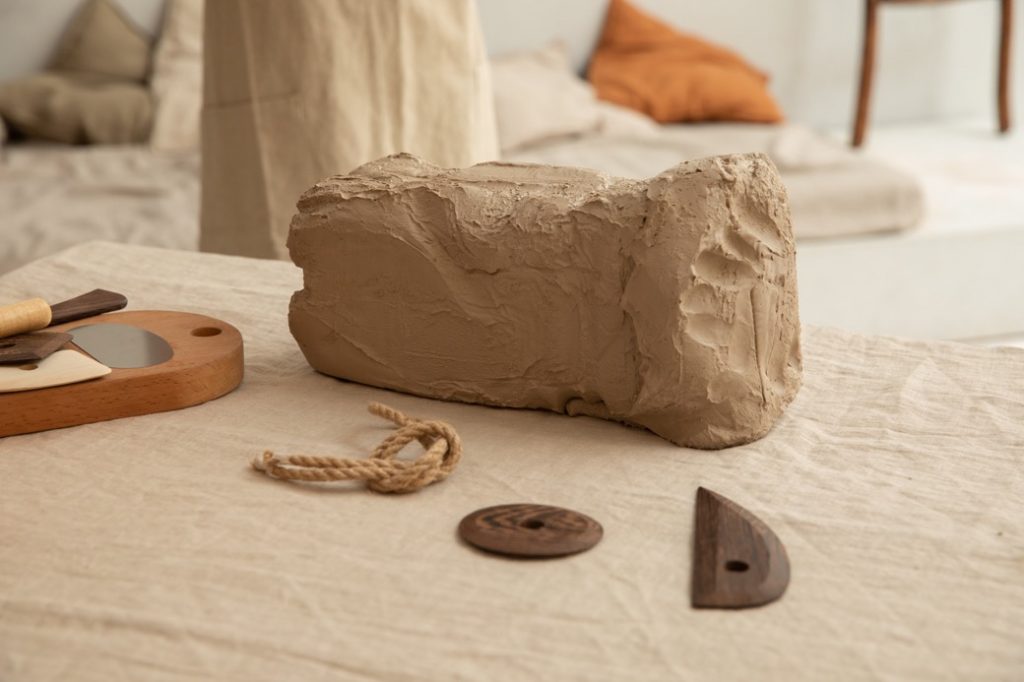
Clay is an outspread material, which can be easily found almost everywhere. Note that it has several transitional states when starting to work with it:
- clay is squishy and elastic when it is wet, which allows you to make any shape you need quickly and easily;
- when drying, clay becomes slightly fragile, so you can carve or scrape something on it;
- after the clay dries completely, the water on it evaporates out, and the vessel becomes brittle.
Once you give your pottery the shape you want, heat it to a high temperature to make it permanent.
4. What Is Pottery Clay Made Out Of?
As mentioned above, clay is the material that comes from the ground and forms due to water pressure, which breaks up and pulverizes the remains of flora, fauna, and minerals into fine pieces.
Larger particles are filtered out through rocks and sand as well. However, potters use not a simple clay but a clay body – a mix of clay and other natural materials and minerals.
“We shape clay into a pot, but it is the emptiness inside that holds whatever we want.”
– Tao Saying
When you do pottery, you take a bit of the pottery clay, put it on the wheel, and spin it till you get the shape you need. After that, you should fire the pottery up until the material will be solidified.
You may also cover the ready pieces with enamels and glazes to make them look more eye-catching and unique.
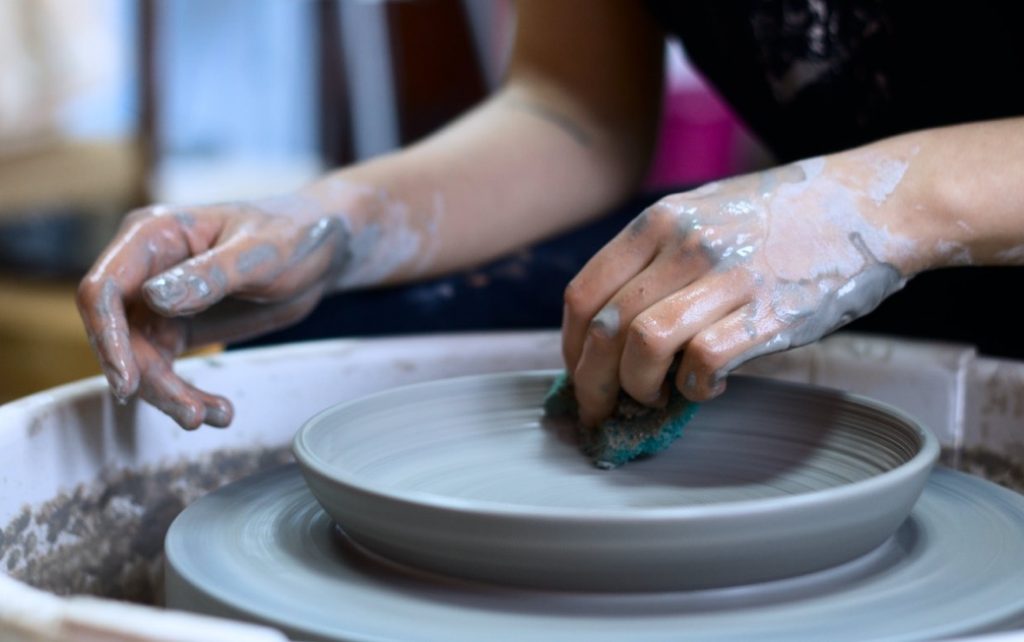
There is no doubt pottery can be an exciting hobby, however, knowing the basics of pottery clay is crucial, and without this information, you won’t be able to get better results every time you take a seat at the potter’s wheel.
5. Is Pottery Clay Gluten-Free?
The pottery clay itself is not gluten-free, as it may contain the remains of flora and fauna, but you can destroy gluten when firing the finished product.
Therefore, if you’re trying to go gluten-free, you can feel free to use the tableware made of pottery clay in your kitchen. This is an excellent solution for those who want to get rid of all potential gluten kitchen equipment with fewer money losses, as you won’t spend a big budget on new ceramic pots and tableware.
All you need to do is get a piece of clay and find a place to create the necessary stuff.
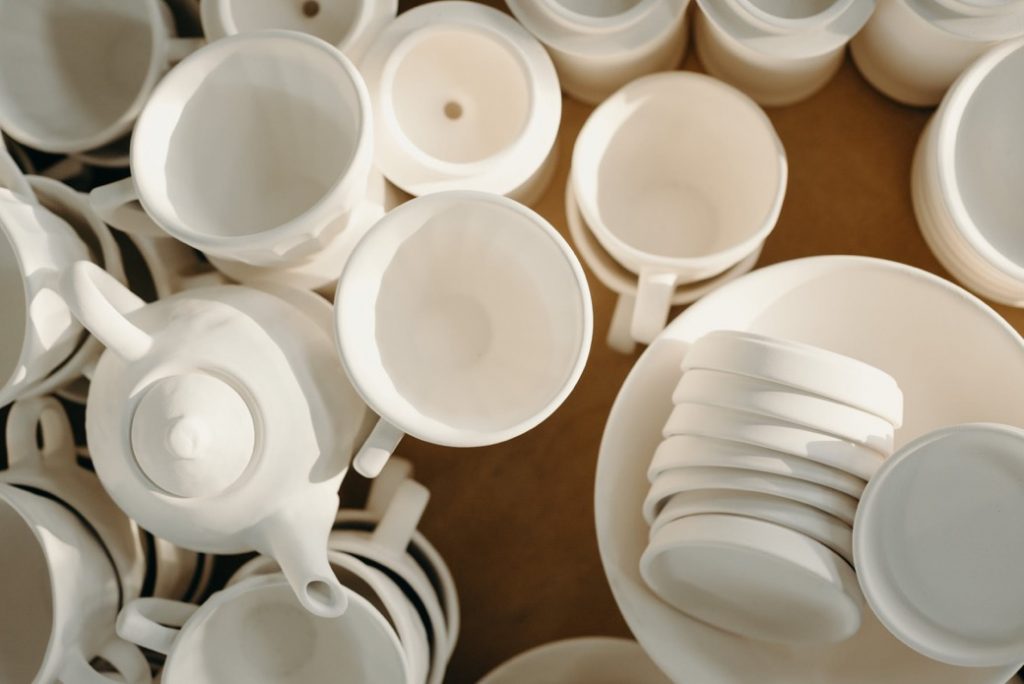
6. Is Pottery Clay Eco-Friendly?
Today, most businesses strive to produce eco-friendly products, as it’s vital for our ecology. Even restaurants and cafes do their best to incorporate sustainability using tableware, bowls, cups, and cutlery from natural materials. You have a unique opportunity to join this tendency once creating tableware and home decoratives from the pottery clay!
As the pottery clay comes from an ordinary natural material – clay, which comes from the ground, is eco-friendly for 100%. Pottery is produced so that it doesn’t harm the environment, so there is no need to worry about the ecology with such items.
“If I create from the heart, nearly everything works: if from the head, almost nothing.”
– Marc Chagal
7. Is Pottery Clay Food Safe?
When selecting the tableware and kitchenware covered by enamels and glazes, the first thing that usually comes to mind is whether it is food safe or not.
As some manufacturers can use materials that can contain lead and other harmful elements, you may put your health at risk if buying them. Therefore, it’s much better to make the stuff with your own hands and natural materials only.

If you create platters, cups, bowls, and other kitchenware using pottery clay, you can rely on its safety and eco-friendliness. Besides, you can make your tableware look unique, as you pick the form of every item on your own.
The objects made of pottery clay are safe themselves. However, make sure the glazes and enamels you use for covering your potter don’t contain chemical elements that will harm health and the body.
8. Does Pottery Clay Contain Lead?
As mentioned above, the clay itself doesn’t contain any harmful heavy metals, e.g., lead, however, this chemical element can be found in some pottery glazes. Therefore, you have to select the covering for your ceramics very attentively!
Remember, if the glazes have lead-bisilicate in their structure, you must be very careful when covering your pottery with it. In case such glazes are misapplied, lead could get into someone’s drink or food, causing severe health problems.
Pick lead-free or low-solubility glazes with low lead-release figures to create safe ceramics. Such glazes meet international standards, so you won’t need to worry when using them with pottery clay.
Consult the manager when selecting enamels for your kitchenware in a specialized store. Ask him or her to show you the invoice with all the necessary information about the product. This will save you from the potential risk of lead poisoning.
9. How to Store Pottery Clay?
Pottery clay requires some moisture to maintain its malleability, so storing it should preserve that moisture content.
The best way to store pottery clay is to wrap it up in an airtight material – a plastic bag, bubble wrap, etc., and put it in a sealed container. The wrapping will help it retain the moisture, and the container helps protect it from the elements.
10. Is There A Clay That Doesn’t Need Firing?
Yes, this type of clay is known as self-hardening or air-dried clay. It is inexpensive and can be gotten naturally. It is handy for making quick decorative pieces and designs on the spot.
Non-firing clay often melts when exposed to high temperatures. Trust me, I know.
11. How Do You Reuse Hardened Clay?
Hardened clay refers to clay that has been left to dry beyond the leather-hard stage. Though it is difficult to handle, this type of clay can be reused after sufficient moisture has been added.
There are several ways to reuse hardened clay, all of which involve adding water and remodeling.
12. How Do You Make Clay Usable Again?
More often than not, one might end up with more clay than they need, so some of it is bound to be forgotten and dry out to the point where it becomes rigid.
Here are a few tricks that can help revive the clay by increasing the moisture content:
- Drill holes in the clay, fill with water, and leave for two to three days;
- Break up the clay and let the pieces sit in a bucket of water for one or two days;
- Break the clay into smaller pieces, wrap it with a wet towel, and put it in a plastic bag for a couple of days;
- In the case of non-hardening or air-dried clay, go ahead and knead the clay for 10 to 15 minutes. The kneading and your body temperature should be enough to soften the clay till it’s useable
When reclaiming clay, make sure that the water is evenly distributed to all parts of the clay. If it becomes too soft, you drain the water out and knead dry the clay a bit.
Whether it is handmade or store-bought pottery or ceramics, a good maintenance culture is the surest way to go in ensuring their prolonged existence.
13. Can You Add Clay To Dry clay?
When clay becomes dry, it loses the ability to be shaped unless it is restored. When clay dries up, adding fresh clay does not precisely change things: the dried-out clay needs to be restored to be suitable for use.
When the clay has dried past the leather hardness stage, it has completely lost its malleability and cannot be used – or joined with fresh clay – without added moisture.
However, the exception to this rule is in using fresh clay to make accessories for already-hard clay, like sculpting.
14. What Happens If You Don’t Fire Clay?
Some clay works, like sculptures, are done without firing. While there might not be observable differences between fired and unfired clay, a few remarkable differences exist in their basic structure.
When fired, clay becomes akin to stone, and depending on its thickness; it is more durable than non-fired clay. Non-fired clay breaks easily when the water content changes – something that is absent in fired clay.
15. How Do You Store Earthenware Clay?
The best way to store earthenware clay is to keep it in a sealed container with a lining.
For earthenware clay, the moisture content is crucial for its usability, so holding it should be about preserving its water content.
The lining makes sure that the moisture is sealed inside the clay, while the container should be sealed shut to eliminate the worst of the harsh climate.
In addition to sealing in the moisture, earthenware clay -and all types of clay- usually produce the best results when stored in places away from direct heat and sunlight.
16. Why Do You Wedge The Clay?
According to some seasoned potters, this is one of the most critical steps to be taken when working with clay—in pottery, wedging means kneading the clay firmly until trapped air pockets are released.
Wedging should not be confused with kneading, which means to fold the clay enough times that the end product is durable pieces of pottery.
The primary reason why you should wedge clay is that when air bubbles get trapped in the clay, during firing, they can evaporate… and leave unsightly patches of bubbles
17. What Is the Strongest Clay?
If you’re interested in the hardest clay, pay attention to Fimo.
It is one of the most rocklike polymer clays, so get ready for your skin to feel very sore after kneading this material. In case you’re looking for the most robust air dry clay, pick Premier, Premix, La Doll, or Creative Paperclay.
Conclusion
Pottery is a vast and fascinating topic for exploration. The experts of clay art spend the whole life mastering their pottery skills, and no person would know absolutely everything about ceramics. Therefore, regardless of whether you want to do pottery as a hobby or start making and selling tableware and decoratives from clay, you must learn the basics about pottery clay first.
After you look through this article, you’ll get a fundamental understanding of what pottery clay is made of and whether it contains hazardous elements or not. This knowledge won’t help you to create a vase or a cup from clay, nevertheless, they will allow you deep into the clay art.
If you want to begin creating ceramics, there is a lot of information about the main pottery techniques. Besides, potters are always ready to share their knowledge with both newbies and other experts. So take a piece of pottery clay, throw it on the potter’s wheel, and start forming the item you want to make with your hands.

